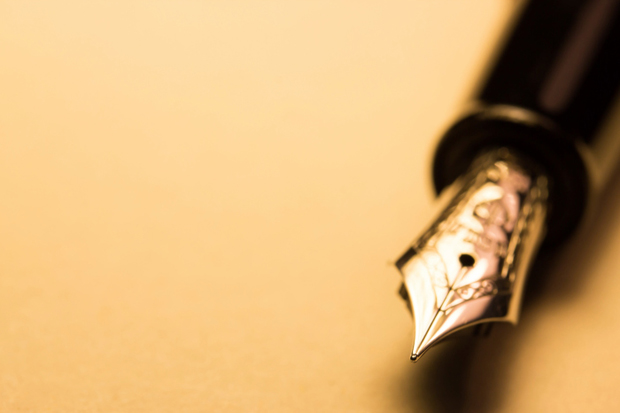Every working day before I start pounding the keyboard of my ridiculously flashy 27-inch iMac, I perform a little ritual. I straighten the fountain pens I keep on my desk, and make sure they are fully inked.
Though I always have an eye for my next acquisition, I currently have just six pens, which are fuelled by four bottles of ink I keep next to them — Waterman black and serenity blue, Pelikan turquoise and Parker red. Three of the pens are Parkers, and my clear favourite is the greatest mass-produced pen of all time, the sleek Parker 51, with the distinctive hooded nib which first appeared in 1941, yet looks like the front end of a futuristic high-speed train.
I have a particular reason to love this pen as it belonged to the great W.F. Deedes. It was given to me by his daughter Lucy when he died in 2007, just as I was completing his authorised biography.
From images on the true-believing fan blogs devoted to the ‘51’, I date Bill’s model back to the late 1950s. This means he could not have landed with it at Normandy in 1944, when he won an MC. But it would have been with him through much of his political career and then his editorship of the Daily Telegraph. I like to picture him scribbling final edits on the statement he had typed out for John Profumo in 1963 flatly denying any sexual relationship with Christine Keeler. When my biography of Bill came out seven years ago and people asked me to sign a copy, it was to thrill to whip out the ‘51’ and explain its history to the buyer of the book.
But the fountain pen should not be regarded as a historical curiosity: global sales are actually increasing. Last Christmas Eve I encountered a scene of utter mayhem in the pen department of John Lewis on Oxford Street as shoppers fought over the remaining models. Sales of fountain pens across the group rose 9 per cent last year, and are also booming on Amazon, which some might think is a bit rich. ‘Children like the individual quality of a fountain pen, the way the nib shapes itself to your writing,’ says Natasha Stoddart, a John Lewis stationery buyer.
If you assumed the fountain pen was dying out in schools, you would be wrong, though it is true that children tend to use cartridges rather than bottled ink. At our daughter’s primary school, the children must prove the quality of their handwriting with a pencil before securing a coveted ‘pen licence’, which allows them to write in ink in class. Our daughter has exploited her pen licence to the full and now has three fountain pens, which is good going for a ten-year-old.
Parker and Lamy of Germany seem to be strongly favoured by the young penmen of north London. With their cheerful design and superb engineering, the latter are the Volkswagen Golfs of the pen world. I keep two Lamys as my workhorses, one with medium nib, one with broad, as the pen enthusiast always wants to keep his options open. Times have changed since my school days, when most boys had Platignums, but I favoured an Osmiroid 75, a model which I am faintly appalled to see is now described by eBay sellers as ‘vintage’.
Many people are prejudiced against the fountain pen because they remember the ink-stained fingers and ruined shirts of their youth. Sadly, my ‘51’ is prone to leaking, but my modern pens have never let me down, even on long-haul flights, because the design of the ink chambers is vastly improved.
On the face of it, it is hard to explain why the fountain pen is fighting back even as we all write fewer letters, and almost no cheques. In part, it is a reaction against spending all our working lives in front of a computer screen. I recently wrote a short Kindle Single on the 40th anniversary of Mrs Thatcher becoming Tory leader (‘Against All Odds’). This is a piece of work that will never have any physical existence and can only be read on a screen, yet I found I printed it out when I had finished. To sink into an armchair and make the necessary amendments — here with a broad nib Lamy in serenity blue, there with Bill Deedes’s ‘51’ in more reproachful red — was deeply soothing after days of squinting grimly into a screen.
Filling a fine fountain pen gives the same satisfaction as polishing a well-made shoe. There is that physical sense of holding something lasting. When my overpriced iMac starts playing up in a few years’ time, it will be carted off to China or Africa to be stripped down for scrap, and quite possibly for details of my online banking habits. The fountain pen holds its secrets, and its dignity.
Got something to add? Join the discussion and comment below.
Get 10 issues for just $10
Subscribe to The Spectator Australia today for the next 10 magazine issues, plus full online access, for just $10.
Stephen Robinson’s The Remarkable Lives of Bill Deedes was published in 2009.
You might disagree with half of it, but you’ll enjoy reading all of it. Try your first month for free, then just $2 a week for the remainder of your first year.














Comments
Don't miss out
Join the conversation with other Spectator Australia readers. Subscribe to leave a comment.
SUBSCRIBEAlready a subscriber? Log in